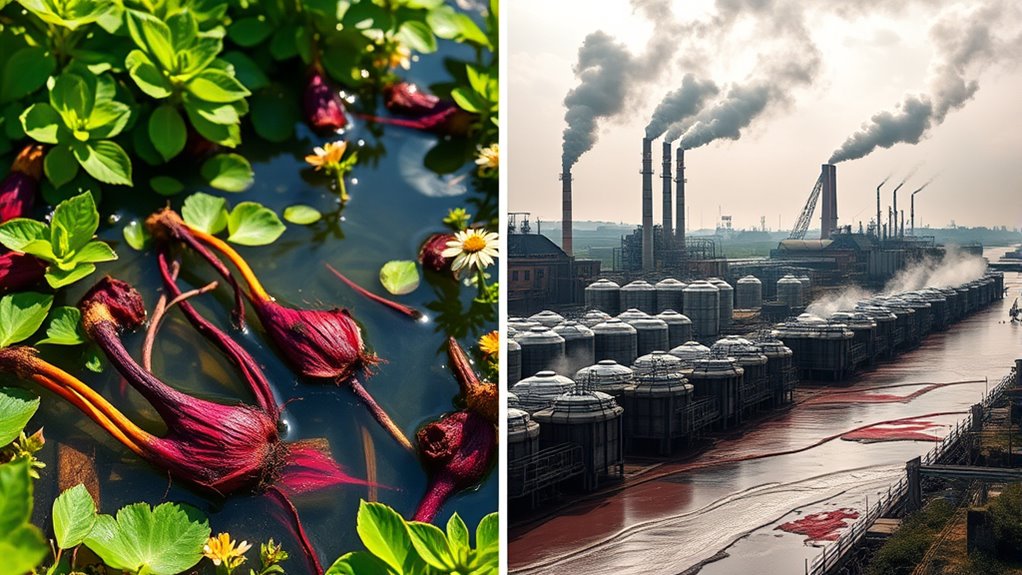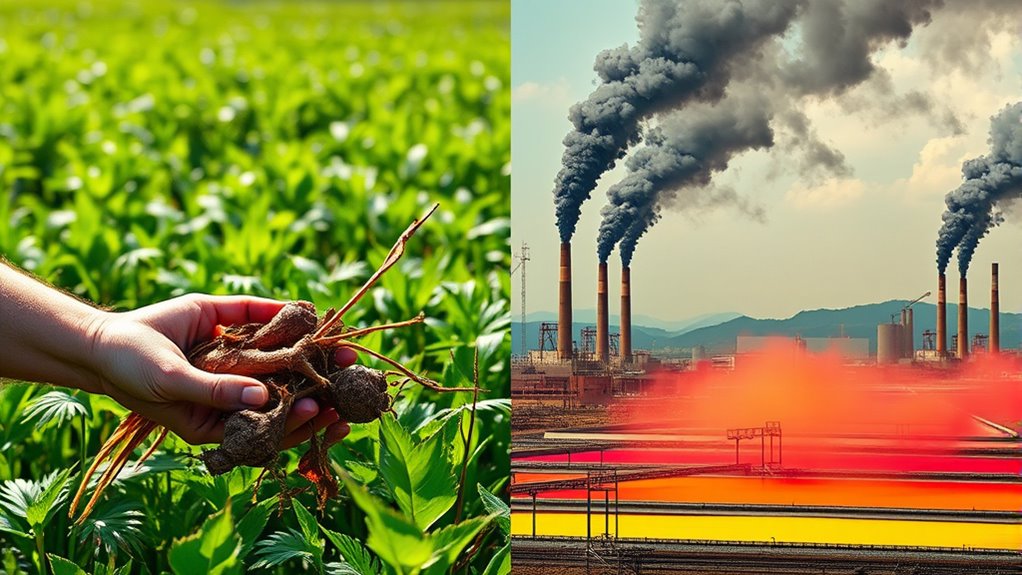When comparing natural and synthetic dyes, natural dyes are usually better for the environment since they come from renewable resources and require less energy to produce. They also cause less pollution and avoid toxic chemicals common in synthetic dyes, which can harm water and air quality. Synthetic dyes offer vibrant, long-lasting colors but often come with higher environmental costs. Keep exploring to uncover more about how choosing between these dyes impacts sustainability and the planet.
Key Takeaways
- Natural dyes are eco-friendly, renewable, and generate minimal environmental pollution during harvesting and processing.
- Synthetic dyes are energy-intensive to produce and release pollutants, including toxic chemicals into water and air.
- Natural dyes typically have lower carbon footprints but may fade faster, requiring additional treatments for durability.
- Synthetic dyes offer vibrant, consistent colors with high colorfastness, but their production harms ecosystems.
- Choosing between them involves balancing environmental sustainability with practical needs like durability and color quality.

When choosing dyes for textiles, understanding the differences between natural and synthetic options is essential. Natural dyes come from plant, animal, or mineral sources and are often seen as more eco-friendly because they typically involve eco friendly harvesting practices that minimize environmental harm. These dyes usually require less energy during extraction and processing, and they often use renewable resources. However, you should be aware that natural dyes can present some challenges, particularly regarding colorfastness. Natural dyes tend to fade faster when exposed to sunlight or repeated washing, which can limit their practicality for everyday use. This colorfastness challenge means you might need to treat or mordant the fibers with additional chemicals, sometimes reducing the eco benefits. Despite these hurdles, natural dyes are gaining popularity among environmentally conscious consumers who value sustainability and traditional methods. Additionally, advancements in mordanting techniques can improve the colorfastness of natural dyes, making them more viable for various applications.
On the other hand, synthetic dyes are produced from petrochemicals, making their manufacturing process highly industrialized and energy-intensive. While they may provide vibrant, consistent colors and are easier to apply on a large scale, synthetic dyes often pose considerable environmental concerns. The production process releases pollutants into water and air, and the dyes themselves can contain toxic chemicals that are difficult to remove from wastewater. This can lead to water pollution and harm aquatic ecosystems. Additionally, synthetic dyes tend to have superior colorfastness, which means garments retain their color longer and resist fading better, reducing the need for frequent re-dyeing or disposal. However, these advantages come at the cost of environmental sustainability, especially considering the non-renewable resources used and the pollution generated during manufacturing. The contrast in environmental impacts between these dye types underscores the importance of considering sustainable practices in textile dyeing.
Choosing between natural and synthetic dyes involves balancing environmental impact and practicality. Natural dyes offer a more sustainable approach when harvested and processed responsibly, but they require careful handling to overcome colorfastness challenges. Synthetic dyes, while efficient and vibrant, contribute markedly to environmental degradation due to their chemical makeup and manufacturing footprint. If you’re aiming for eco-conscious choices, you might consider natural dyes, but be prepared to address their limitations. Alternatively, advancements in sustainable synthetic dyes are emerging, aiming to reduce environmental harm while maintaining performance. Ultimately, your decision should reflect your values, the intended use of the textiles, and a commitment to minimizing ecological impact. Both options have their trade-offs, but understanding these differences helps you make informed, responsible choices that support environmental sustainability.
Frequently Asked Questions
How Do Dye Sources Affect Local Ecosystems?
When dye sources are harvested irresponsibly, they can cause biodiversity loss and water pollution. You might notice ecosystems suffering as plants and animals lose habitats or become contaminated from runoff. Using natural dyes from sustainable sources helps protect ecosystems, while synthetic dyes often contribute to pollution. By choosing environmentally friendly options, you help preserve biodiversity and reduce water contamination, making a positive impact on local ecosystems.
Are Natural Dyes More Sustainable Long-Term Than Synthetic Dyes?
You’ll find that natural dyes are generally more sustainable long-term because they’re biodegradable and rely on renewable resources. Studies show that natural dyes break down faster in the environment, reducing pollution. Unlike synthetic dyes, which often contain harmful chemicals and non-renewable petrochemicals, natural dyes have higher resource renewal rates. This makes them a better choice for eco-friendly practices, supporting environmental health over time.
What Are the Health Risks Associated With Synthetic Dyes?
Synthetic dyes can pose health risks like chemical toxicity, which may cause skin irritation or more serious health issues with prolonged exposure. You might also experience allergic reactions, such as rashes or respiratory problems, especially if you have sensitivities. It’s important to handle these dyes carefully and wear protective gear when working with them, as they contain chemicals that can affect your health over time.
Can Natural Dyes Match the Colorfastness of Synthetic Dyes?
Natural dyes generally have lower colorfastness compared to synthetic dyes, but with proper mordanting, their durability can improve markedly. You can enhance natural dye durability by selecting the right mordants and techniques, making the colorfastness comparison more favorable. While synthetic dyes typically offer superior longevity, natural dyes can still provide vibrant, lasting colors when correctly processed, allowing you to enjoy eco-friendly options without sacrificing too much in colorfastness.
How Do Production Costs Compare Between Natural and Synthetic Dyes?
You’ll find that natural dyes often have higher production costs, roughly 20-30% more than synthetic dyes, mainly due to their labor-intensive extraction and limited supply. Manufacturing expenses for natural dyes are higher because of the need for large quantities of raw materials and longer processing times. However, as demand for eco-friendly options grows, some producers are finding ways to reduce costs, making natural dyes more competitive.
Conclusion
Think of dyes as the colors of your future wardrobe; choose natural dyes like tending a garden—carefully, sustainably, with harmony. Synthetic dyes, on the other hand, are like a storm—bright and quick but leaving behind pollution and harm. By opting for natural dyes, you’re planting seeds for a healthier planet, painting a future where beauty and environmental care grow hand in hand. Your choices can turn the tide from chaos to calm, one vibrant hue at a time.








